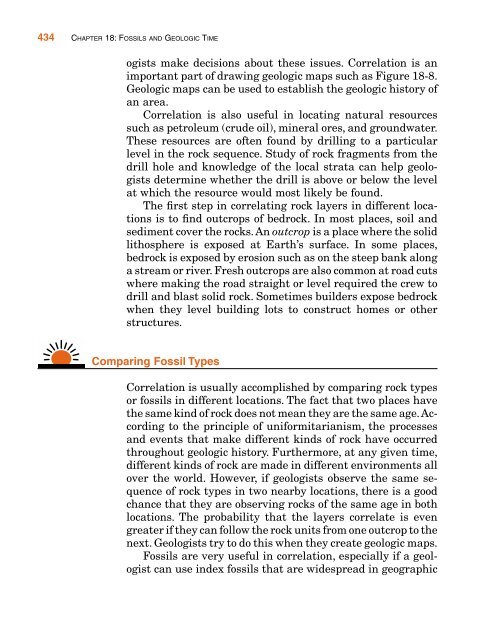Chapter 18 Fossils and Geologic Time
Chapter 18 Fossils and Geologic Time
Chapter 18 Fossils and Geologic Time
Create successful ePaper yourself
Turn your PDF publications into a flip-book with our unique Google optimized e-Paper software.
434 CHAPTER <strong>18</strong>: FOSSILS AND GEOLOGIC TIME<br />
ogists make decisions about these issues. Correlation is an<br />
important part of drawing geologic maps such as Figure <strong>18</strong>-8.<br />
<strong>Geologic</strong> maps can be used to establish the geologic history of<br />
an area.<br />
Correlation is also useful in locating natural resources<br />
such as petroleum (crude oil), mineral ores, <strong>and</strong> groundwater.<br />
These resources are often found by drilling to a particular<br />
level in the rock sequence. Study of rock fragments from the<br />
drill hole <strong>and</strong> knowledge of the local strata can help geologists<br />
determine whether the drill is above or below the level<br />
at which the resource would most likely be found.<br />
The first step in correlating rock layers in different locations<br />
is to find outcrops of bedrock. In most places, soil <strong>and</strong><br />
sediment cover the rocks. An outcrop is a place where the solid<br />
lithosphere is exposed at Earth’s surface. In some places,<br />
bedrock is exposed by erosion such as on the steep bank along<br />
a stream or river. Fresh outcrops are also common at road cuts<br />
where making the road straight or level required the crew to<br />
drill <strong>and</strong> blast solid rock. Sometimes builders expose bedrock<br />
when they level building lots to construct homes or other<br />
structures.<br />
Comparing Fossil Types<br />
Correlation is usually accomplished by comparing rock types<br />
or fossils in different locations. The fact that two places have<br />
the same kind of rock does not mean they are the same age.According<br />
to the principle of uniformitarianism, the processes<br />
<strong>and</strong> events that make different kinds of rock have occurred<br />
throughout geologic history. Furthermore, at any given time,<br />
different kinds of rock are made in different environments all<br />
over the world. However, if geologists observe the same sequence<br />
of rock types in two nearby locations, there is a good<br />
chance that they are observing rocks of the same age in both<br />
locations. The probability that the layers correlate is even<br />
greater if they can follow the rock units from one outcrop to the<br />
next. Geologists try to do this when they create geologic maps.<br />
<strong>Fossils</strong> are very useful in correlation, especially if a geologist<br />
can use index fossils that are widespread in geographic

















